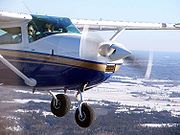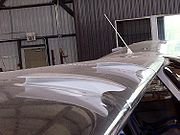
Vortex generator
Encyclopedia



Vane
Vane may refer to:* Cooper vane* Vane anemometer* Weather vaneA vane is also each of the parts besides the shaft in a pennaceous feather...
or bump that creates a vortex
Vortex
A vortex is a spinning, often turbulent,flow of fluid. Any spiral motion with closed streamlines is vortex flow. The motion of the fluid swirling rapidly around a center is called a vortex...
. Vortex generators can be found on many devices, but the term is most often used in aircraft
Aircraft
An aircraft is a vehicle that is able to fly by gaining support from the air, or, in general, the atmosphere of a planet. An aircraft counters the force of gravity by using either static lift or by using the dynamic lift of an airfoil, or in a few cases the downward thrust from jet engines.Although...
design.
Vortex generators delay flow separation
Flow separation
All solid objects travelling through a fluid acquire a boundary layer of fluid around them where viscous forces occur in the layer of fluid close to the solid surface. Boundary layers can be either laminar or turbulent...
and aerodynamic stalling, thereby improving the effectiveness of wings and control surfaces (e.g., Embraer 170 and Symphony SA-160
Symphony SA-160
-Similar aircraft:* Alpha 2000 * Cessna 150* Cessna 152* Cessna 172* Diamond DA20* Liberty XL2-References:* * * * * * -External links:* *...
). For swept-wing transonic designs, they alleviate potential shock-stall
Shock-stall
A shock stall is a stall caused by the airflow over an aircraft's wings being disturbed by shock waves when flying at or near to the aircraft's critical Mach number.Shock stall is the separation of the boundary layer behind the shock wave....
problems (e.g., Harrier, Blackburn Buccaneer
Blackburn Buccaneer
The Blackburn Buccaneer was a British low-level subsonic strike aircraft with nuclear weapon delivery capability serving with the Royal Navy and the Royal Air Force between 1962 and 1994, including service in the 1991 Gulf War...
, Gloster Javelin
Gloster Javelin
The Gloster Javelin was an "all-weather" interceptor aircraft that served with Britain's Royal Air Force in the late 1950s and most of the 1960s...
).
Method of operation
Vortex generators are most often used to delay flow separation. To solve this problem, they are often placed on the external surfaces of vehicles. On aircraft they are installed on the front third of a wingWing
A wing is an appendage with a surface that produces lift for flight or propulsion through the atmosphere, or through another gaseous or liquid fluid...
in order to maintain steady airflow over the control surfaces at the trailing edge. They are typically rectangular or triangular, about 80% as tall as the boundary layer
Boundary layer
In physics and fluid mechanics, a boundary layer is that layer of fluid in the immediate vicinity of a bounding surface where effects of viscosity of the fluid are considered in detail. In the Earth's atmosphere, the planetary boundary layer is the air layer near the ground affected by diurnal...
, and run in spanwise lines near the thickest part of the wing. They can be seen on the wings and vertical tails of many airliner
Airliner
An airliner is a large fixed-wing aircraft for transporting passengers and cargo. Such aircraft are operated by airlines. Although the definition of an airliner can vary from country to country, an airliner is typically defined as an aircraft intended for carrying multiple passengers in commercial...
s. Vortex generators are positioned obliquely so that they have an angle of attack
Angle of attack
Angle of attack is a term used in fluid dynamics to describe the angle between a reference line on a lifting body and the vector representing the relative motion between the lifting body and the fluid through which it is moving...
with respect to the local airflow.
A vortex generator creates a tip vortex which draws energetic, rapidly-moving air from outside the slow-moving boundary layer into contact with the aircraft skin. The boundary layer normally thickens as it moves along the aircraft surface, reducing the effectiveness of trailing-edge control surfaces; vortex generators can be used to remedy this problem, among others, by "re-energizing the boundary layer".
After-market installation
Many aircraft carry vane vortex generators from time of manufacture, but there are also after-market suppliers who sell VG kits to improve the STOLSTOL
STOL is an acronym for short take-off and landing, a term used to describe aircraft with very short runway requirements.-Definitions:There is no one accepted definition of STOL and many different definitions have been used by different authorities and nations at various times and for a myriad of...
performance of some light aircraft. After-market suppliers claim (i) that VGs lower stall speed and reduce take-off and landing speeds, and (ii) that VGs increase the effectiveness of ailerons, elevators and rudders, thereby improving controllability and safety at low speeds. For home-built and experimental kitplane
Homebuilt aircraft
Also known as amateur-built aircraft or kit planes, homebuilt aircraft are constructed by persons for whom this is not a professional activity. These aircraft may be constructed from "scratch," from plans, or from assembly kits.-Overview:...
s, VGs are cheap, cost-effective and can be installed quickly; but for certified aircraft installations, certification
Type certificate
A Type Certificate, is awarded by aviation regulating bodies to aerospace manufacturers after it has been established that the particular design of a civil aircraft, engine, or propeller has fulfilled the regulating bodies' current prevailing airworthiness requirements for the safe conduct of...
costs can be high, making the kits relatively expensive .
Owners fit after-market VGs primarily to gain benefits at low speeds, but a downside is that such VGs may reduce cruise speed slightly. In tests performed on a Cessna 182
Cessna 182
The Cessna 182 Skylane is an American four-seat, single-engine, light airplane, built by Cessna of Wichita, Kansas. It has the option of adding two child seats, installed in the baggage area....
and a Piper PA-28-235 Cherokee
Piper Cherokee
The Piper PA-28 Cherokee is a family of light aircraft designed for flight training, air taxi, and personal use. It is built by Piper Aircraft....
, independent reviewers have documented a loss of cruise speed of 1.5 to 2 kn (2.9 to 3.9 km/h) . However, these losses are relatively minor, since an aircraft wing at high speed has a small angle of attack, thereby reducing VG drag to a minimum.
Owners have reported that on the ground, it can be harder to clear snow and ice from wing surfaces with VGs than from a smooth wing, but VGs are not generally prone to in-flight icing as they reside within the boundary layer of airflow. VGs may also have sharp edges which can tear the fabric of airframe covers and may thus require special covers to be made.
For twin-engined aircraft, manufacturers claim that VGs reduce single engine control speed (Vmca
V speeds
In aviation, V-speeds are standard terms used to define airspeeds important or useful to the operation of all aircraft including fixed-wing aircraft, gliders, autogiros, helicopters, and dirigibles...
), increase zero fuel and gross weight, improve the effectiveness of aileron
Aileron
Ailerons are hinged flight control surfaces attached to the trailing edge of the wing of a fixed-wing aircraft. The ailerons are used to control the aircraft in roll, which results in a change in heading due to the tilting of the lift vector...
s and rudder
Rudder
A rudder is a device used to steer a ship, boat, submarine, hovercraft, aircraft or other conveyance that moves through a medium . On an aircraft the rudder is used primarily to counter adverse yaw and p-factor and is not the primary control used to turn the airplane...
, provide a smoother ride in turbulence and make the aircraft a more stable instrument platform
Increase in maximum takeoff weight
Many of the vortex generator kits available for light twin-engine airplanes bring with them the added benefit of an increase in maximum takeoff weight. This might seem paradoxical because installation of vortex generators does not increase the strength of the wing.The maximum takeoff weight of a twin-engine airplane is determined by structural requirements and single-engine climb performance requirements (which are lower for a lower stall speed). For many light twin-engine airplanes, the single-engine climb performance requirements determine a lower maximum weight rather than the structural requirements. Consequently, anything that can be done to improve the single-engine-inoperative climb performance will bring about an increase in maximum takeoff weight.
In the USA from 1945 until 1991,
the one-engine-inoperative climb requirement for multi-engine airplanes with a maximum takeoff weight of 6000 lb (2,721.6 kg) or less was as follows:
where
 is the stalling
is the stallingStall (flight)
In fluid dynamics, a stall is a reduction in the lift coefficient generated by a foil as angle of attack increases. This occurs when the critical angle of attack of the foil is exceeded...
speed in the landing configuration in miles per hour.
Installation of vortex generators can usually bring about a slight reduction in stalling speed of an airplane and therefore reduce the required one-engine-inoperative climb performance. The reduced requirement for climb performance allows an increase in maximum takeoff weight, at least up to the maximum weight allowed by structural requirements.
An increase in maximum weight allowed by structural requirements can usually be achieved by specifying a maximum zero fuel weight or, if a maximum zero fuel weight is already specified as one of the airplane's limitations, by specifying a new higher maximum zero fuel weight.
For these reasons, vortex generator kits for many light twin-engine airplanes are accompanied by a reduction in maximum zero fuel weight and an increase in maximum takeoff weight.
The one-engine-inoperative rate-of-climb requirement does not apply to single-engine airplanes, so gains in the maximum takeoff weight (based on stall speed or structural considerations) are less significant compared to those for 1945–1991 twins.
After 1991, the airworthiness certification requirements in the USA specify the one-engine-inoperative climb requirement as a gradient independent of stalling speed, so there is less opportunity for vortex generators to increase the maximum takeoff weight of multi-engine airplanes whose certification basis is FAR 23 at amendment 23-42 or later.
Maximum landing weight
Because most light twin engined aircraft landing weights are determined by structural considerations and not stall speed, most VG kits only increase the take-off weight available and not the landing weight. In these cases increasing the landing weight requires either structural modifications or else re-testing the aircraft to demonstrate that the certification requirements are still met at the higher landing weight.See also
- TurbulatorTurbulatorA turbulator is a device that turns a laminar flow into a turbulent flow. Turbulent flow can be desired on parts of the surface of an aircraft wing or in industrial applications such as heat exchangers and the mixing of fluids.-Airfoil turbulators:...
- Boundary layer suctionBoundary layer suctionBoundary layer suction is technique in which an air pump is used to extract the boundary layer at the wing or the inlet of an aircraft. Improving the air flow can reduce drag. Improvements in fuel efficiency have been estimated as high as 30%....
- Boundary layer controlBoundary layer controlBoundary layer control refers to methods of controlling the behaviour of fluid flow boundary layers. This holds particular interest in aeronautical engineering because drag may be reduced whilst achieving high lift ....
- Circulation control wingCirculation control wingA circulation control wing is a form of high-lift device for use on the main wing of an aircraft to increase the lift coefficient. CCW technology has been in the research and development phase for over sixty years, and the early models were called blown flaps.The CCW works by increasing the...

